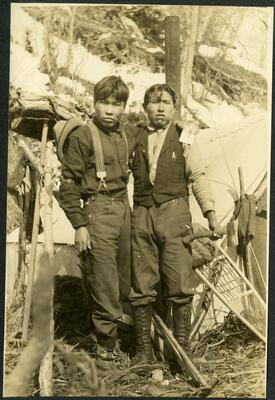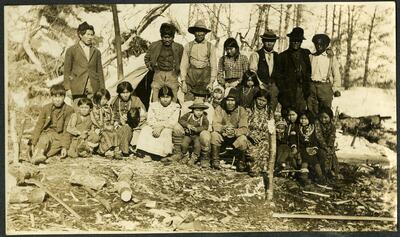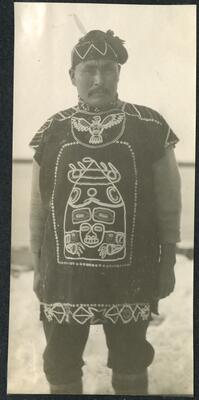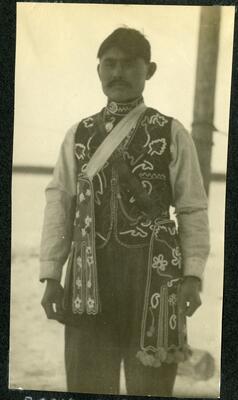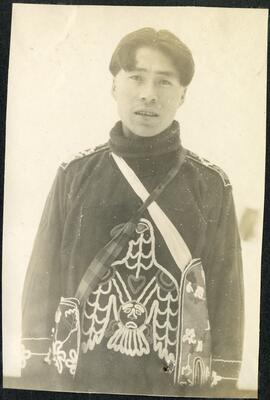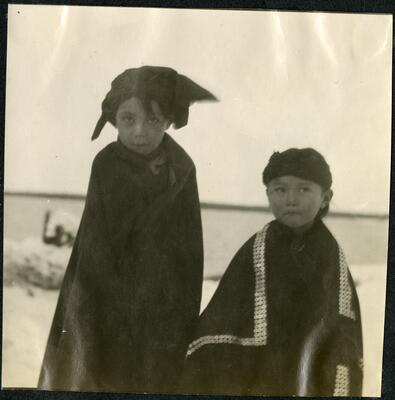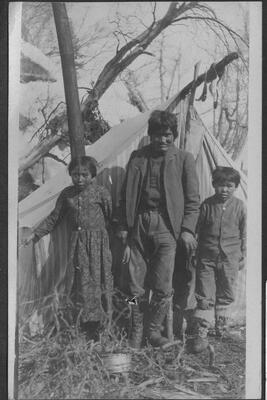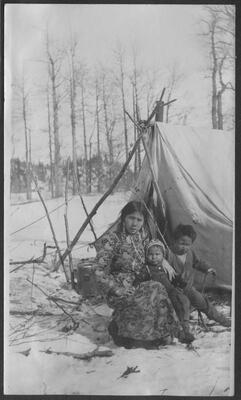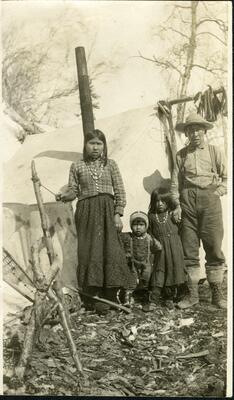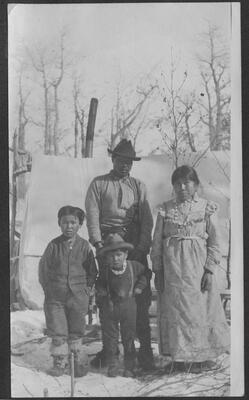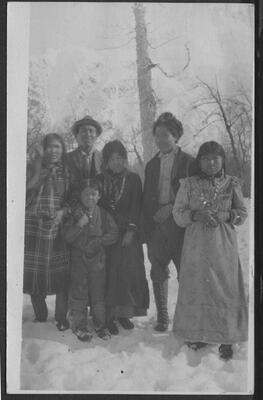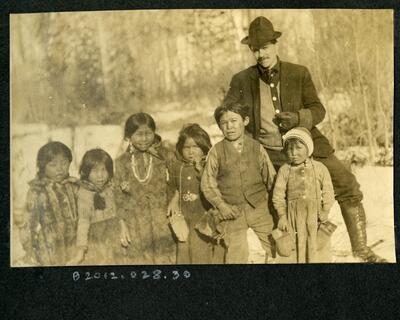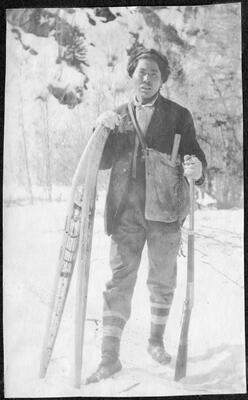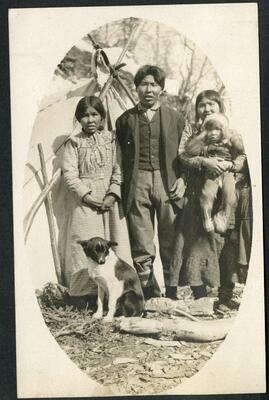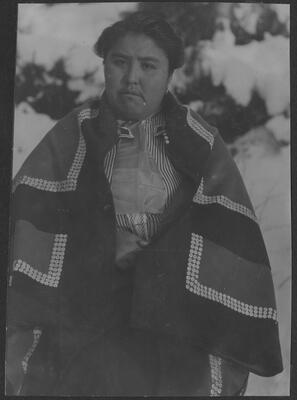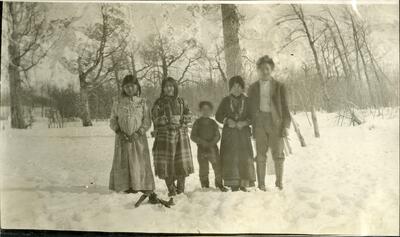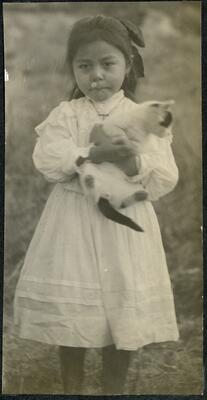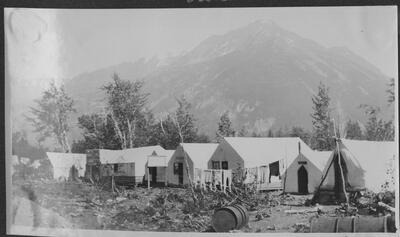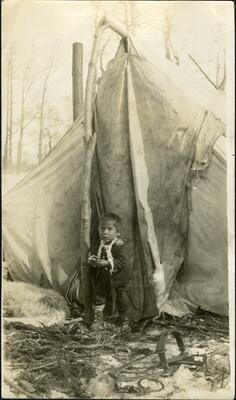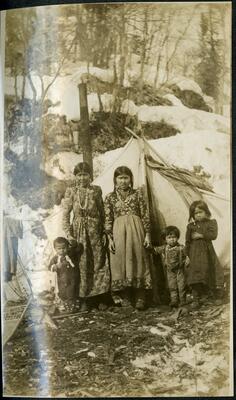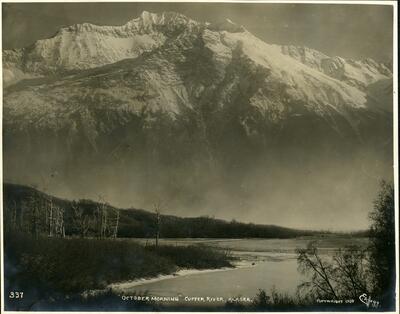| | 1 — | [winter scene, buildings in distance?] |
| 2 — | [two young Native men outside tent, man at left with only one leg, crutches propped
between men, snowshoes in background. At AFN 2015, men identified as possibly Ahtna] |
| | 3 — | [winter scene, snow drifted over railroad grade?] |
| | 4 — | [winter scene, blasting near railroad grade?] |
| | 5 — | [dog (?) swimming in river] |
| | 6 — | [frozen waterfall on hillside, early spring; see also image .186] |
| | 7 — | [man standing in open doorway of log cabin; same as image .281] |
| | 8 — | [snow-covered buildings in forest] |
| | 9 — | [Native family standing outside tent; same as image .20] |
| | 10 — | [avalanche over railroad tracks] |
| | 11 — | [woman wearing button blanket] |
| | 12 — | [group of seven Native children playing] |
| 13 — | [group of 22 Natives; same as image .140; at AFN 2014, identified as Ahtna based on
clothing, man standing at left tentatively identified as Doc Billum] |
| 14 — | [Native man with regalia; same as image .27. At AFN 2015, tentatively identified as Eyak,
possibly Stickloo or Stiklu of Katalla] |
| 15 — | [Native man with regalia, octopus bag; at AFN 2014, tentatively identified as Chief
Charley Sanford] |
| 16 — | [Native man with regalia. At AFN 2015, tentatively identified as Yakutat Native]
|
| 17 — | [Native children, one wearing button blanket] |
| 18 — | [Native man and two children standing outside tent] |
| 19 — | [Native woman with two children, coffee pot, outside tent] |
| 20 — | [Native family standing outside tent; same as image .9] |
| | 21 — | [railroad tracks through melting avalanche area; same as image .117] |
| | 22 — | [paddlewheel steamboat underway] |
| | 23 — | [Childs Glacier and beginning of construction on Million Dollar Bridge, looking
downstream from Miles Lake] |
| | 24 — | [shore, lake, mountain; same as image .111] |
| | 25 — | [tent, mountains] |
| 26 — | [Native family outside tent; same as image .139] |
| | 27 — | [Native man with regalia; same as image .14] |
| 28 — | [group of six Natives; same as image .138; at AFN 2014, woman at right identified as
chief’s daughter based on her dress and regalia] |
| | 29 — | [group of five Natives] |
| 30 — | [six Native children and Caucasian man; same as image .76] |
| | 31 — | [Native boy outside tent] |
| | 32 — | [railroad construction camp] |
| 33 — | [Native man with snowshoes, rifle] |
| 34 — | [Native woman with three children outside tent; same as images .73 & .108] |
| 35 — | [two Native girls] |
| 36 — | [Natives and dog outside tent; same as image .71. At AFN 2015, identified as Ahtna] |
| 37 — | [woman wearing button blanket. At AFN 2015, identified as Tlingit] |
| | 38 — | [two men lounging on hillside, one with camera case; see also images .83 and .300] |
| | 39 — | [Caucasian man standing, same as in image .7] |
| | 40 — | [Native man with regalia] |
| | 41 — | [Native man with regalia] |
| 42 — | [Native family standing in snow; same as image .82] |
| 43 — | [Native girl in white dress with kitten] |
| | 44 — | [ice cave] |
| | 45 — | [winter scene] |
| | 46 — | [ice cave] |
| | 47 — | [five-dog team pulling freight sled] |
| | 48 — | [construction camp, large tent with sign: “Laundry and Baths”] |
| 49 — | [construction camp, tents with signs “Tiekel Store and Reading Room” and “Restaurant”] |
| | 50 — | [overview of Camp Tiekel at Mile 101 (same image published in Lone Janson, The Copper
Spike, p. 96)] |
| | 51 — | [Tiekel Store and Reading Room; same as image .124] |
| | 52 — | [railroad tracks—along Copper River?; same as image .232] |
| | 53 — | [lake, forest, mountains] |
| | 54 — | [glacier, mountains] |
| | 55 — | [construction camp, winter] |
| | 56 — | [construction camp, winter] |
| | 57a — | [construction camp, winter]
|
| | 57b — | Kennicott Pot Hole [river rapids] |
| | 58 — | .61—[Childs Glacier] |
| | 62 — | [bears in camp] |
| | 63 — | [dogs] |
| | 64 — | [trestle under construction, winter] |
| 65 — | .68—[steam shovel operating] |
| | 69 — | [haystacks, people, not in Alaska] |
| | 70 — | [sled dogs and two men in winter] |
| | 71 — | [Natives and dog outside tent; same as image .36] |
| 72 — | [Natives outside tent] |
| | 73 — | [Native woman with three children outside tent; same as images .34 and .108] |
| 74 — | [Native boy and leg-hold trap outside tent] |
| | 75 — | [Native girl outside tent; same as image .107] |
| | 76 — | [six Native children and Caucasian man; same as image .30] |
| | 77 — | .80—[scenes along the railroad] |
| | 81 — | [Childs Glacier] |
| | 82 — | [Native family standing in snow; same as image .42] |
| | 83 — | [two men lounging on hillside; see also images .38 and .300] |
| | 84 — | [construction camp, railroad tracks and snow; same as images .110 and .154, see also
image .171] |
| | 85 — | .87—[winter scenes] |
| | 88 — | [railroad tracks and river] |
| | 89 — | [scene with railroad tracks] |
| | 90 — | [scenery] |
| | 91 — | [two men with cameras] |
| | 92 — | .95—[scenes along railroad; .93 is the same as image .256] |
| | 96 — | [pile driver; similar photo in The Copper Spike, p. 97 is captioned “A pile driver at work on
the crossing of the Tiekel River”; see also image .131 and .143-.145] |
| | 97 — | .98—[winter construction of approach trestle—Kuskulana River?] |
| | 99 — | .102—scenes along railroad |
| | 103 — | [train stopped on approach trestle to Kuskulana River bridge, under construction] |
| | 104 — | [Copper River crossing just east of Chitina, mile 132—temporary trestle was replaced
each year after ice went out] |
| | 105 — | Kuskalina [Kuskulana] Bridge |
| 106 — | [Native woman and children outside tent] |
| 107 — | [Native girl outside tent; same as image .75] |
| | 108 — | [Native woman with three children outside tent; same as images .34 and .73] |
| | 109 — | [construction tents and boxcar] |
| | 110 — | [construction camp, railroad tracks and snow; same as images .84 and .154] |
| | 111 — | [Shore, lake, mountain; same as image .24] |
| | 112 — | [four engines on trestle] |
| | 113 — | [trestle next to frozen river; same image as .163] |
| | 114 — | [horse teams grading fill; see also image .165] |
| | 115 — | [two men atop log cache]
|
| | 116 — | [railroad grade on hillside above river] |
| | 117 — | [railroad tracks through melting avalanche area; same as image .21] |
| | 118 — | [steam shovel loading rail cars; same image as .128] |
| | 119a — | [steam shovel loading rail cars] |
| | 119b — | .121—[rotary plows and men clearing tracks] |
| | 122 — | [man with camera case standing in front of windowless log structure] |
| | 123 — | [view of construction camp with railroad tracks and trestle; one tent marked with an
“X”] |
| | 124 — | Tiekel Store and Reading Room; same as image .51 |
| | 125 — | .127—[mountains, lakes] |
| | 128 — | [steam shovel loading rail cars; same image as .118] |
| | 129 — | [steam shovel loading rail cars; burnt forest in background] |
| | 130 — | [man walking between rails on large steel bridge—Million Dollar Bridge?] |
| | 131 — | [pile driver; similar photo in The Copper Spike, p. 97 is captioned “A pile driver at work
on the crossing of the Tiekel River”; see also images .96 and .143-.145] |
| | 132 — | .134—[bear cub] |
| | 135 — | .137—[man standing in ice cave] |
| | 138 — | .139—[Native families] |
| | 140 — | [group of 22 Natives; same as image .13] |
| | 141 — | [dog in front of frame house] |
| | 142 — | [scene along railroad—Copper River?] |
| | 143 — | .145—[pile driver; similar photo in The Copper Spike, p. 97 is captioned “A pile driver at
work on the crossing of the Tiekel River”; see also images .96 and .131] |
| | 146 — | [frame house in deep snow] |
| 147 — | [Native family; man holding porcupine carcass or skin bag] |
| | 148 — | [railroad construction camp] |
| | 149 — | [Native tents, sled; same as image ] |
| | 150 — | Kuskalina [Kuskulana] Camp |
| | 151 — | .153—[mountains, lakes] |
| | 154 — | [construction camp, railroad tracks and snow; same as images .84 and .110, see also
image .171] |
| | 155 — | Bonanza Ore Bunkers [Kennecott mill and manager’s house, very early] |
| | 156 — | Making Camp [erecting pole tent frames] |
| | 157 — | [trestle work in winter, Gilahina Bridge?] |
| | 158 — | .160—[mountains, scenery] |
| | 161 — | [bridge, waterfall—not Alaska] |
| | 162 — | [railroad tracks and snowshed] |
| | 163 — | [trestle next to frozen river; same image as .113] |
| | 164 — | [burnt cityscape—probably Wallace, Idaho in the aftermath of “The Great Fire of
1910”
2
]
2
http://en.wikipedia.org/wiki/Great_Fire_of_1910
|
| | 165 — | [horse teams grading fill; see also image .114] |
| | 166 — | [paddlewheel steamboat underway on lake, springtime] |
| | 167 — | [paddlewheel steamboat Nizina at rest on Copper River; same as image .277] |
| | 168 — | [railroad flatcars loaded with men, at construction camp] |
| | 169 — | [railroad cut; same image as .189] |
| | 170 — | Teikel (Tiekel) Camp / C.R. & N.W. Ry |
| | 171 — | [construction camp, railroad tracks and snow; see also images .84 and .110] |
| 172 — | .174—[Native families] |
| | 175 — | [boys in trees—not Alaska?] |
| | 176 — | On the St. Joe’s River [not Alaska?] |
| | 177 — | N[orthern] P[acific Railway] Flume [not Alaska] |
| | 178 — | Plasser [Placer?—snowy town in valley, not Alaska] |
| | 179 — | [roadbed and unfinished tunnel] |
| | 180 — | [roadbed with steamboat at landing in distance] |
| | 181 — | [pedestrian bridge over water] |
| | 182 — | Upper End of Wood Canyon Copper River—E. A. Hegg |
| | 183 — | [railway along river] |
| | 184 — | .185—[scenery] |
| | 186 — | [frozen waterfall on hillside, early spring; see also image .6] |
| 187 — | “October Morning” Copper River, Alaska / Copyright 1909 / E. A. Hegg |
| | 188 — | .190—[roadbed and cuts] |
| | 191 — | Court House [Wallace, Idaho] |
| | 192 — | N[orthern P[acific Railway] Depot [Wallace, Idaho] |
| | 193 — | [frame house, not Alaska?] |
| | 194 — | Sixth St—Wallace [Idaho] |
| | 195 — | [construction camp in winter] |
| | 196 — | [winter scene] |
| | 197 — | [opening to small cave or tunnel] |
| | 198 — | [building—warehouse?—in winter; see also image .252] |
| | 199 — | .200—[cows, log building, family—not Alaska?] |
| | 201 — | [turreted building—not Alaska] |
| | 202 — | [temporary trestle crossing Copper River?] |
| | 202 — | 205—[scenery; .205 is same image as .233] |
| | 206 — | [railroad bridge—not Alaska?] |
| | 207 — | [sailing ship at anchor—not Alaska?] |
| | 208 — | [men working loaded sleigh through ice next to river] |
| | 209 — | .211—[scenery] |
| | 212 — | [snowed-in tunnel; same image as .216] |
| | 213 — | Chitina River |
| | 214 — | [ice cave] |
| | 215 — | [man looking down ravine to broad river valley; same image as .219] |
| | 216 — | [snowed-in tunnel; same image as .212] |
| | 217 — | [snowed-in roadbed and tunnel] |
| | 218 — | [snowed-in roadbed; same image as .270]
|
| | 219 — | [man looking down ravine to broad river valley; same image as .215] |
| | 220 — | [two people on sled pulled by horse] |
| | 221 — | [snowed-in flatbed rail cars of the Copper River Ry. Co.; camp in background] |
| | 222 — | [rotary snowplow in action; same as image .287] |
| | 223 — | [trestle and cut] |
| | 224 — | [wooden trestle, under construction] |
| | 225 — | [river scene] |
| | 226 — | Childs Glacier |
| | 227 — | [overview of town next to river—not Alaska? Photo credit: M. A. Jacobson] |
| 228 — | Crossing Copper River [men placing logs across melting ice] |
| | 229 — | .231—[scenery] |
| | 232 — | [railroad tracks—along Copper River?; same image as .52] |
| | 233 — | [scenery; same as image .203] |
| | 234 — | [rotary snowplow in action?] |
| | 235 — | [railroad grade above river] |
| | 236 — | [waterfall] |
| | 237 — | [construction camp] |
| | 238 — | [Natives and tents; same as image .149] |
| | 239 — | [tents on edge of lake] |
| | 240 — | [railroad tracks] |
| | 241 — | [scenery] |
| | 242 — | [tents and log cabin] |
| | 243 — | [mountain stream; same as image .269] |
| | 244 — | [horse teams grading fill; same as image .165] |
| | 245 — | [man in parka and fur mittens] |
| | 246 — | [man in parka wearing snowshoes; see also image .291; image has hole in it] |
| | 247 — | [log buildings under construction—Chitina?] |
| | 248 — | [confluence of Chitina River with Copper River?] |
| | 249 — | 4/16-09 / Beginning erection of superstructure / 300’ span / Manning [Million Dollar
Bridge] |
| | 250 — | [buildings on edge or large river] |
| | 251 — | [railroad grade, mountains] |
| | 252 — | [building—warehouse?—in winter; see also image .198] |
| | 253 — | [railroad trestle in distance, above Copper River?; same as image .268] |
| | 254 — | [winter scenery] |
| | 255 — | [tents and railroad tracks in winter] |
| | 256 — | [rock wall above stream; same as image .93] |
| | 257 — | [river gorge—Kuskulana?] |
| | 258 — | [scenery—Copper River delta?] |
| | 259 — | [shacks with American flags—not Alaska?] |
| | 260 — | [railroad grade during construction; same as image .285] |
| | 261 — | [horse teams grading fill] |
| | 262 — | [scenery] |
| | 263 — | .264—[ice caves]
|
| | 265 — | [locomotive and cars underway] |
| | 266 — | [railroad grade under construction] |
| | 267 — | [railroad tracks and river] |
| | 268 — | [railroad trestle in distance, above Copper River?; same as image .253] |
| | 269 — | [mountain stream; same as image .243] |
| | 270 — | [snowed-in roadbed; same image as .218; image is torn] |
| | 271 — | [man with rifle, winter] |
| | 272 — | [snowed-in railroad bed, telephone pole] |
| | 273 — | [construction camp, winter] |
| | 274 — | [ice cave] |
| | 275 — | [scenery] |
| | 276 — | [scenery] |
| | 277 — | paddlewheel steamboat Nizina at rest on Copper River; same as image .167] |
| | 278 — | [scenery] |
| | 279 — | [construction camp, group of men, locomotives meeting?, late winter] |
| | 280 — | [horse teams grading fill] |
| | 281 — | [man standing in open doorway of log cabin; same as image .7] |
| | 282 — | [trestle above river] |
| | 283 — | [scenery] |
| | 284 — | [railroad tunnel next to river] |
| | 285 — | [railroad grade during construction; same as image .260] |
| | 286 — | [construction camp in winter] |
| | 287 — | [rotary snowplow in action; same as image .222] |
| | 288 — | [rotary snowplow and men with shovels] |
| | 289 — | [man seated in front of tent with wooden door] |
| | 290 — | [man standing in forest] |
| | 291 — | [man in parka seated in snow, wearing snowshoes; see also image .246] |
| | 292 — | [steamboat Nizina at landing above Abercrombie Rapids; see p. 76 of The Copper Spike] |
| | 293 — | [rails and tunnel] |
| | 294a — | [locomotive and cars on trestle; this is one of the four American Locomotive Company
engines acquired in 1907 and used on the Copper River & Northwestern Railway (see Howard
Clifford, Alaska/Yukon Railroads: An Illustrated History (Arlington, Washington: Oso
Publishing, 1999), pp. 199-200] |
| | 294b — | [man with hat] |
| | 295 — | [scenery] |
| | 296 — | [railroad tracks] |
| | 297a — | [scenery] |
| | 297b — | [railroad tracks] |
| | 298 — | [locomotive and cars on trestle, crossing a stream] |
| | 299 — | [Log Cabin Saloon; writing on reverse says “this is a photo of one of the saloons in
Chitina the new town . . .] |
| | 300 — | [two seated men, one with camera; see also images .38 and .83]
The remaining five images have been separated from the album and have partially legible
messages on the reverse: |
| | 301 — | [postcard]: Constructing steel bridge, Round Island Channel, Copper River Ry., April 19,
1909; [penciled message on reverse from A.A.D., dated 12/6/09; see also image .249] |
| | 302 — | [scenery; message on reverse, signed by A.A.D.] |
| | 303 — | [postcard: man standing in snow, sent from Cordova 1/11/10] |
| | 304 — | [postcard: man standing with one foot on wooden box labeled “ELAINE OIL,” railroad
trestle visible in background, signed by A.A.D.] |
| | 305 — | [postcard: hand-written on front “Making for Cordova,” image is of a small steamship
underway]
Guide updated: October 26, 2016 |
